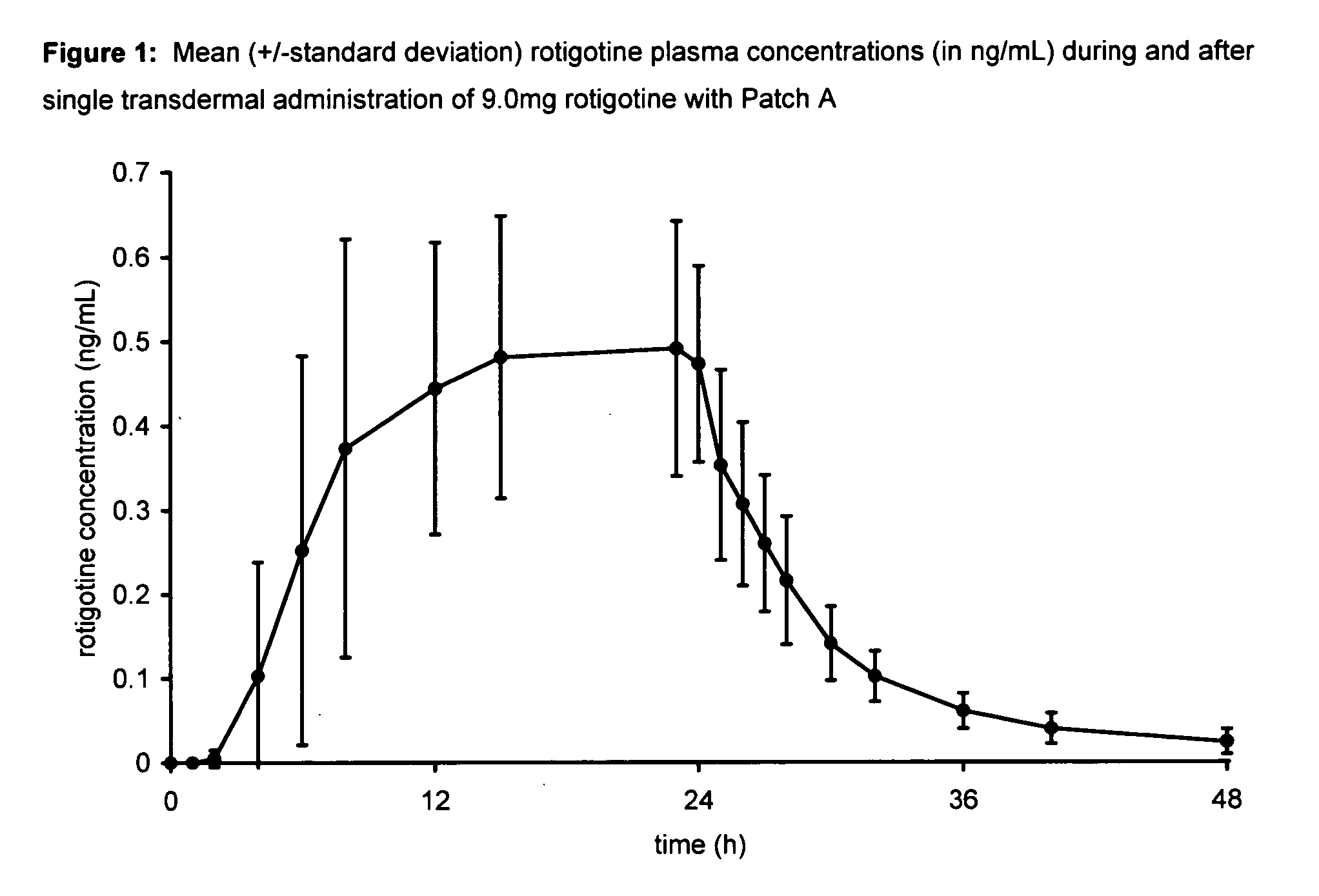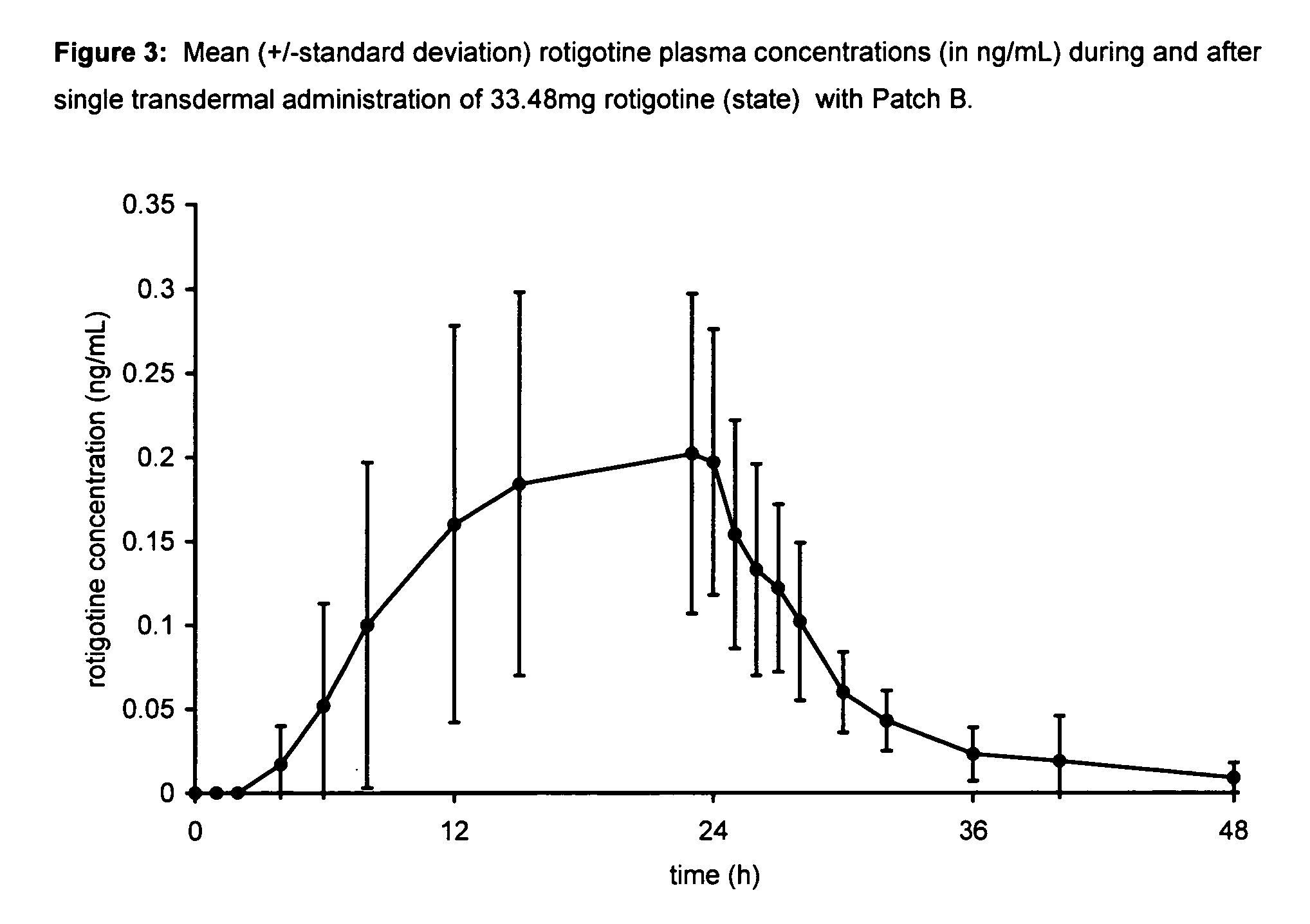Transdermal therapeutic system for Parkinson's Disease
a technology of transdermal therapy and parkinson's disease, which is applied in the field of skin patches, can solve the problems of disease-related symptoms, loss of tonic dopamine secretion and dopamine-related modulation, and deficiency of dopamine in certain brain regions, and achieve the effect of effective treatmen
- Summary
- Abstract
- Description
- Claims
- Application Information
AI Technical Summary
Benefits of technology
Problems solved by technology
Method used
Image
Examples
example 1
Study Design and Subject Population
[0103] A single-center, open-label, single administration, three-way cross-over clinical trial was performed to assess the blood levels and comparative bioavailability of rotigotine from silicone and acrylic transdermal patches. The acrylic transdermal patches were made in accordance with the teachings of WO 99 / 49852. The silicone transdermal patches were made in accordance with the teachings of U.S. Patent Application Publication No. US 2003 / 0026830 at paragraphs 38-42, U.S. Patent Application Publication No. US 2003 / 0027793 at paragraphs 37-41 and U.S. Pat. No. 6,884,434, columns 5-6, Example 2 and comprised the following components:
Patch AName of Ingredientmg / 20 cm2 patchRotigotine9.00Silicone adhesive 430144.47Silicone adhesive 420144.46Providone2.00Sodium metabisulfite0.0009Ascorbyl palmitate0.02Vitamin E (DL-α-tocopherol)0.05Scotchpak 1109 (backing film)20cm2
[0104]
Patch BName of Ingredientmg / 20 cm2 patchRotigotine HCl33.48Sodium trisilica...
example 2
Study Design and Subject Population
[0114] A single-center, open-label, multiple dose clinical trial was performed to assess the pharmacokinetics of a rotigotine transdermal patch during 14 days of once-daily patch administration to 30 healthy male volunteers. The subjects were treated for two days with placebo patches and then either with placebo or rotigotine patches for 14 days (i.e., days 13-16). The silicone transdermal patches were made in accordance with the teachings of U.S. Patent Application Publication No. US 2003 / 0026830 at paragraphs 38-42, U.S. Patent Application Publication No. US 2003 / 0027793 at paragraphs 37-41 and U.S. Pat. No. 6,884,434, columns 5-6, Example 2 and comprised the following layers and components:
Patch CName of Ingredientmg / 10 cm2 patchRotigotine4.50Silicone adhesive 430122.24Silicone adhesive 420122.23Providone1.00Sodium metabisulfite0.00045Ascorbyl palmitate0.010Vitamin E (DL-α-tocopherol)0.025Scotchpak 1109 (backing film)10cm2
[0115] The silicone...
example 3
Study Design and Subject Population
[0120] A single-center, open-label, single-dose, randomized two-way cross-over clinical trial was performed to assess bioequivalence of two different rotigotine-containing silicone patches in 30 healthy male subjects (Caucasian, aged 18-50 years). The first silicone transdermal patches (Patch C) were made in accordance with the teachings of U.S. Patent Application Publication No. US 2003 / 0026830 at paragraphs 38-42, U.S. Patent Application Publication No. US 2003 / 0027793 at paragraphs 37-41 and U.S. Pat. No. 6,884,434, columns 5-6, Example 2 and comprised the following layers and components:
Patch CName of Ingredientmg / 10 cm2 patchRotigotine4.50Silicone adhesive 430122.24Silicone adhesive 420122.23Providone1.00Sodium metabisulfite0.00045Ascorbyl palmitate0.010Vitamin E (DL-α-tocopherol)0.025Scotchpak 1109 (backing film)10cm2
[0121] The second silicone transdermal patches (Patch D) were made in accordance with the teachings of U.S. Patent Applicat...
PUM
| Property | Measurement | Unit |
|---|---|---|
| Time | aaaaa | aaaaa |
| Time | aaaaa | aaaaa |
| Time | aaaaa | aaaaa |
Abstract
Description
Claims
Application Information
 Login to View More
Login to View More - R&D
- Intellectual Property
- Life Sciences
- Materials
- Tech Scout
- Unparalleled Data Quality
- Higher Quality Content
- 60% Fewer Hallucinations
Browse by: Latest US Patents, China's latest patents, Technical Efficacy Thesaurus, Application Domain, Technology Topic, Popular Technical Reports.
© 2025 PatSnap. All rights reserved.Legal|Privacy policy|Modern Slavery Act Transparency Statement|Sitemap|About US| Contact US: help@patsnap.com



